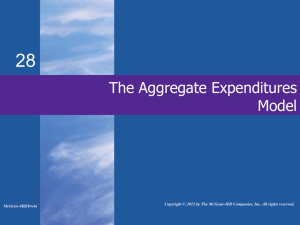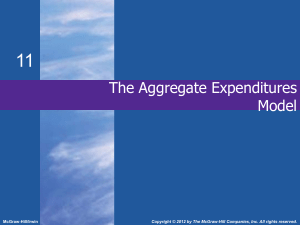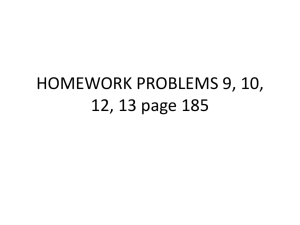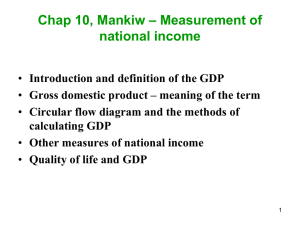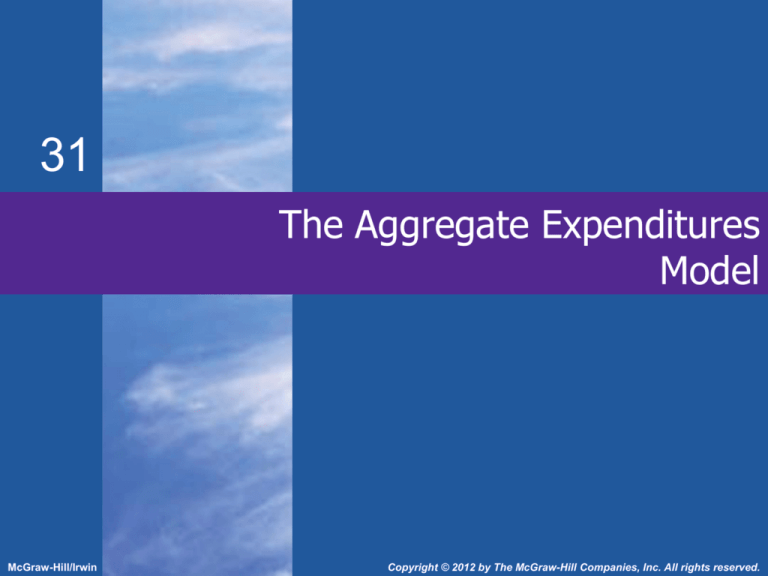
31
The Aggregate Expenditures
Model
McGraw-Hill/Irwin
Copyright © 2012 by The McGraw-Hill Companies, Inc. All rights reserved.
Assumptions and Simplifications
• Use the Keynesian aggregate
•
•
•
LO1
expenditures model
Prices are fixed
GDP = DI
Begin with private, closed economy
• Consumption spending
• Investment spending
Consumption and Investment
Investment
demand
curve
8
20
ID
20
Investment
(billions of dollars)
(a)
Investment demand curve
LO1
Investment Schedule
Investment (billions of dollars)
r and i (percent)
Investment Demand Curve
Investment
schedule
Ig
20
20
Real domestic product, GDP
(billions of dollars)
(b)
Investment schedule
Equilibrium GDP
Determination of the Equilibrium Levels of Employment, Output, and Income: A Private Closed Economy
(2)
Real
Domestic
Output
(and
Income)
(GDP =
DI),*Billio
ns
(3)
Consumption
(C),
Billions
(4)
Saving
(S),
Billions
(1) 40
$370
$375
(2) 45
390
(3) 50
(1)
Possible
Levels of
Employment,
Millions
(5)
Investment
(Ig),
Billions
(6)
Aggregate
Expenditure
(C+Ig),
Billions
(7)
Unplanned
Changes in
Inventories,
(+ or -)
(8)
Tendency of
Employment,
Output, and
Income
$-5
$20
$395
$-25
Increase
390
0
20
410
-20
Increase
410
405
5
20
425
-15
Increase
(4) 55
430
420
10
20
440
-10
Increase
(5) 60
450
435
15
20
455
-5
Increase
(6) 65
470
450
20
20
470
0
(7) 70
490
465
25
20
485
+5
Decrease
(8) 75
510
480
30
20
500
+10
Decrease
(9) 80
530
495
35
20
515
+15
Decrease
(10) 85
550
510
40
20
530
+20
Decrease
Equilibrium
* If depreciation and net foreign factor income are zero, government is ignored and it is assumed that all saving occurs in the household sector of the
economy, then GDP as a measure of domestic output is equal to NI,PI, and DI. Household income = GDP
LO1
Aggregate expenditures, C + Ig (billions of dollars)
Equilibrium GDP
530
C + Ig
(C + Ig = GDP)
510
490
470
450
Equilibrium
point
Aggregate
expenditures
C
Ig = $20 billion
430
410
390
C = $450 billion
370
45°
370 390 410 430 450 470 490 510 530 550
Real domestic product, GDP (billions of dollars)
LO1
Other Features of Equilibrium GDP
• Saving equals planned investment
• Saving is a leakage of spending
• Investment is an injection of
•
LO2
spending
No unplanned changes in inventories
• Firms do not change production
Aggregate expenditures (billions of dollars)
Changes in Equilibrium GDP
(C + Ig)1
(C + Ig)0
(C + Ig)2
510
490
Increase in
investment
470
Decrease in
investment
450
430
45°
430
450
470
490
510
Real domestic product, GDP (billions of dollars)
LO3
Adding International Trade
• Include net exports spending in
•
•
•
LO4
aggregate expenditures
• Private, open economy
Exports create production,
employment, and income
Subtract spending on imports
Xn can be positive or negative
The Net Export Schedule
Two Net Export Schedules (in Billions)
LO4
(1)
Level of GDP
(2)
Net Exports,
Xn1 (X > M)
(3)
Net Exports,
Xn2 (X < M)
$370
$+5
$-5
390
+5
-5
410
+5
-5
430
+5
-5
450
+5
-5
470
+5
-5
490
+5
-5
510
+5
-5
530
+5
-5
550
+5
-5
Net Exports and Equilibrium GDP
C + Ig+Xn1
C + Ig
C + Ig+Xn2
Aggregate expenditures
(billions of dollars)
510
Aggregate expenditures
490 with positive
net exports
Aggregate expenditures
with negative net
exports
470
450
430
45°
Net exports, Xn
(billions of
dollars)
430
LO4
450
470
490
510
Real domestic product GDP (billions of dollars)
+5
0
-5
Positive net exports
450
470
Negative net exports
Xn1
490
Xn2
Real
GDP
International Economic Linkages
• Prosperity abroad
• Can increase U.S. exports
• Exchange rates
• Depreciate the dollar to increase
•
LO4
exports
A caution on tariffs and devaluations
• Other countries may retaliate
• Lower GDP for all
Global Perspective
Source: World Trade Organization, www.wto.org.
LO4
Adding the Public Sector
• Government purchases and
•
LO4
equilibrium GDP
• Government spending is subject to
the multiplier
Taxation and equilibrium GDP
• Lump sum tax
• Taxes are subject to the multiplier
• DI = GDP
Government Purchases and Eq. GDP
The Impact of Government Purchases on Equilibrium GDP
(1)
Real
Domestic
Output and
Income
(GDP=DI),
Billions
(5)
Net Exports
(Xn), Billions
Imports
(M)
(6)
Government
Purchases
(G), Billions
(7)
Aggregate
Expenditures
(C+Ig+Xn+G),
Billions
(2)+(4)+(5)+(6)
$10
$10
$20
$415
20
10
10
20
430
5
20
10
10
20
445
420
10
20
10
10
20
460
(5) 450
435
15
20
10
10
20
475
(6) 470
450
20
20
10
10
20
490
(7) 490
465
25
20
10
10
20
505
(8) 510
480
30
20
10
10
20
520
(9) 530
495
35
20
10
10
20
535
(10) 550
510
40
20
10
10
20
550
(2)
Consumption
(C),
Billions
(3)
Saving (S),
Billions
(4)
Investment
(Ig),
Billions
Exports
(X)
(1) $370
$375
$-5
$20
(2) 390
390
0
(3) 410
405
(4) 430
LO4
Aggregate expenditures (billions of dollars)
Government Purchases and Eq. GDP
C + Ig + Xn + G
C + Ig + X n
C
Government spending
of $20 billion
45°
470
550
Real domestic product, GDP (billions of dollars)
LO4
Taxation and Equilibrium GDP
Determination of the Equilibrium Levels of Employment, Output, and Income: Private and Public Sectors
(1)
Real
Domestic
Output
and
Income
(GDP=DI),
Billions
(7)
Net Exports
(Xn), Billions
(9)
Aggregate
Expenditures
(C+Ig+Xn
+G),
Billions
(4)+(6)+(7)
+(8)
(2)
Taxes
(T),
Billions
(3)
Disposable
Income
(DI),
Billions,
(1)-(2)
(4)
Consumption (C),
Billions
(5)
Saving
(S),
Billions
(6)
Investment (Ig),
Billions
Export
s
(X)
Import
s
(M)
(8)
Government
Purchases
(G),
Billions
(1) $370
$20
$350
$360
$-10
$20
$10
$10
$20
$400
(2) 390
20
370
375
-5
20
10
10
20
415
(3) 410
20
390
390
0
20
10
10
20
430
(4) 430
20
410
405
5
20
10
10
20
445
(5) 450
20
430
420
10
20
10
10
20
460
(6) 470
20
450
435
15
20
10
10
20
475
(7) 490
20
470
450
20
20
10
10
20
490
(8) 510
20
490
465
25
20
10
10
20
505
(9) 530
20
510
480
30
20
10
10
20
520
(10) 550
20
530
495
35
20
10
10
20
535
LO4
Aggregate expenditures (billions of dollars)
Taxation and Equilibrium GDP
C + Ig + Xn + G
Ca + Ig + Xn + G
$15 billion
decrease in
consumption
from a
$20 billion
increase
in taxes
45°
490
550
Real domestic product, GDP (billions of dollars)
LO4
Equilibrium versus Full-Employment
• Recessionary expenditure gap
• Insufficient aggregate spending
• Spending below full-employment GDP
• Increase G and/or decrease T
• Inflationary expenditure gap
• Too much aggregate spending
• Spending exceeds full-employment
GDP
• Decrease G and/or increase T
LO5
Aggregate expenditures
(billions of dollars)
Equilibrium versus Full-Employment
AE0
AE1
530
510
Recessionary
expenditure
gap = $5 billion
490
Full
employment
45°
490
510
530
Real GDP
(a)
Recessionary expenditure gap
LO5
Aggregate expenditures
(billions of dollars)
Equilibrium versus Full-Employment
AE2
530
Inflationary
expenditure
gap = $5 billion
AE0
510
490
Full
employment
45°
490
510
530
Real GDP
(b)
(billions of dollars)
LO5
Application: The Recession of 2007-09
• December 2007 recession began
• Aggregate expenditures declined
• Consumption spending declined
• Investment spending declined
• Recessionary expenditure gap
LO5
Application: The Recession of 2007-09
• Federal government undertook
Keynesian policies
• Tax rebate checks
• $787 billion stimulus package
LO5
Say’s Law, Great Depression, Keynes
• Classical economics
• Say’s Law
• Economy will automatically adjust
• Laissez-faire
• Keynesian economics
• Cyclical unemployment can occur
• Economy will not correct itself
• Government should actively manage
macroeconomic instability

